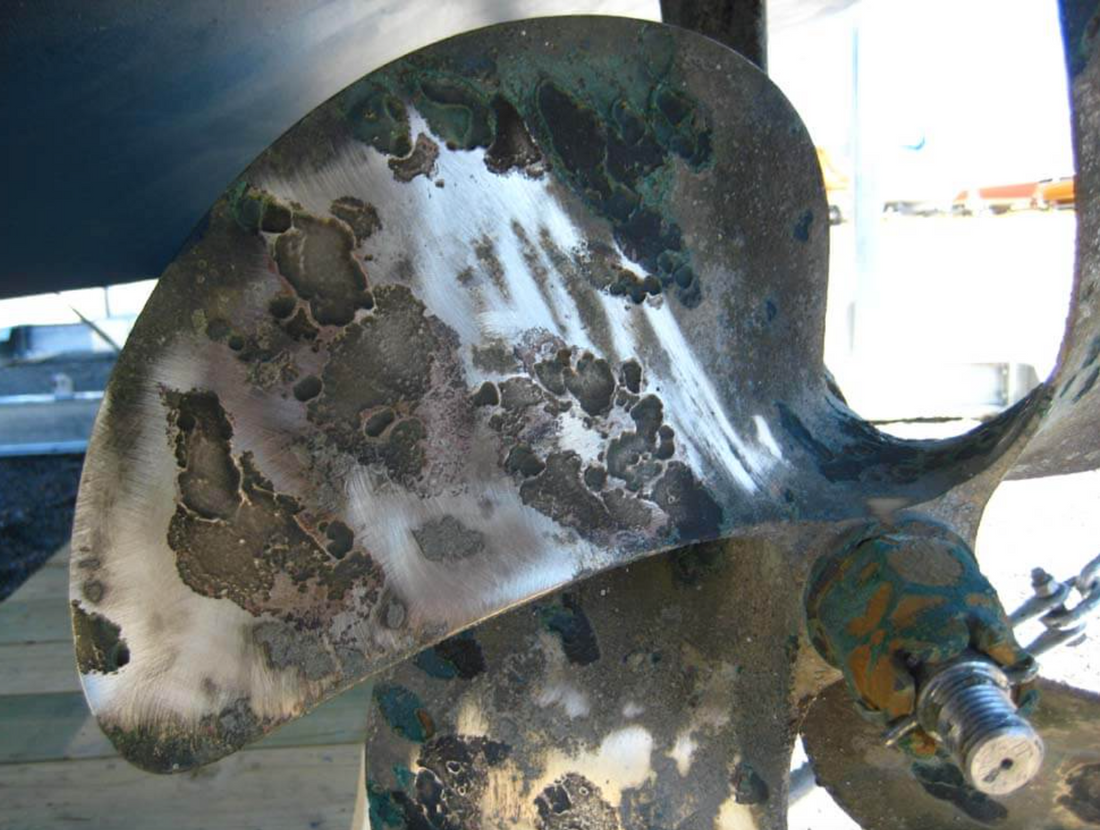
Galvanic Corrosion & Electrolysis
Share
On boat propellers, both electrolysis and galvanic corrosion can lead to costly damage, but they stem from different causes and require distinct prevention strategies. Understanding the distinction is crucial for effective boat maintenance.
Galvanic Corrosion
What it is: Galvanic corrosion is a natural electrochemical process that occurs when two different metals are in electrical contact and submerged in an electrolyte, such as saltwater. Think of it like a mini-battery forming. The less "noble" metal (higher on the galvanic series, meaning it's more reactive) will act as the anode and corrode, sacrificing itself to protect the more "noble" metal (the cathode). On a boat, this often happens between a bronze propeller (more noble) and a stainless steel shaft, or an aluminum outdrive (less noble) and a stainless steel propeller.
How it looks: Early signs can include blistering paint below the waterline, a white powdery substance on exposed metal, and eventually deep pitting as the metal is eaten away.
How to prevent it:
-
Sacrificial Anodes: This is the primary defense against galvanic corrosion. Anodes are made of metals that are even less noble than the metals they are protecting. When attached to your boat's underwater metal components (like propellers, shafts, rudders, and trim tabs), they become the anode in the galvanic cell and corrode first, sparing your more valuable parts.
-
Material matters: Anodes come in different materials suited for various water types:
- Zinc: Best for saltwater.
- Aluminum: Effective in both saltwater and brackish water. (Also a good environmentally conscious choice as zinc anodes can contain cadmium.)
- Magnesium: Only for freshwater, as it corrodes too quickly in saltwater.
- Regular inspection and replacement: Anodes should be inspected frequently and replaced when they are about 50% consumed. In saltwater, this might be as often as every six months. Never paint over anodes, as this will render them ineffective.
- Proper electrical contact: Ensure anodes have clean, unpainted surfaces where they connect to the boat's components, and that their fasteners are tight for good electrical continuity.
-
Material matters: Anodes come in different materials suited for various water types:
- Bonding Systems: Many boats have a bonding system, which is a network of wires that electrically connect all underwater metal components to a common point, which is then connected to the sacrificial anodes. This ensures that all protected metals share the same electrical potential, directing corrosion to the anodes.
-
-
solation of Dissimilar Metals: Where possible, avoid direct contact between dissimilar metals. Use insulating washers, gaskets, or non-conductive coatings to separate them.
-
Protective Coatings: Applying specialized marine coatings, like foul-release coatings on propellers, can help insulate the metal from the electrolyte, further reducing the potential for galvanic corrosion.
Electrolysis (Stray Current Corrosion)
What it is: Electrolysis, more accurately termed "stray current corrosion," is an accelerated form of corrosion caused by an external electrical current. Unlike galvanic corrosion, which is a naturally occurring battery, stray current corrosion is like plugging a faulty appliance into that battery, supercharging the corrosive process. This current typically originates from:
-
- Faulty boat wiring: Poorly installed or damaged wiring on your own vessel can leak current into the water.
- Neighboring boats: Faulty electrical systems on adjacent boats in a marina can create a circuit through the water and your boat's metal components.
- Shore power connections: Improperly wired shore power pedestals or faulty ground leads can introduce stray currents into your boat's electrical system.
How it looks: Stray current corrosion is often much more rapid and severe than galvanic corrosion. It can lead to significant pitting, rapid deterioration, and even catastrophic failure of metal components, sometimes in a matter of days or weeks. If your anodes are disappearing unusually fast, it's a strong indicator of stray current.
How to prevent it:
-
Sacrificial Anodes (Secondary Defense): While primary for galvanic corrosion, anodes also offer a degree of protection against stray current. They will be consumed much faster if stray current is present, serving as a warning sign.
-
Regular Electrical Inspections: Have a qualified marine electrician regularly inspect your boat's wiring and electrical systems. Look for frayed wires, corroded connections, and any signs of current leakage.
-
Galvanic Isolators: These devices are installed in your boat's shore power ground wire. They block the low-voltage DC currents that can cause stray current corrosion while still allowing AC fault currents to pass, ensuring safety. They prevent current from flowing between boats or from shore power through the water.
- Isolation Transformers: For the highest level of protection, an isolation transformer completely isolates your boat's electrical system from the shore power ground. This provides maximum safety and protection against both galvanic and stray current issues from shore power.
- Shutting Off Power: When leaving your boat, especially for extended periods, turn off your main shore power breaker and disconnect unnecessary DC loads to minimize the risk of stray current originating from your own vessel.
- Awareness in Marinas: Be mindful of the condition of neighboring boats and marina wiring. If you suspect issues, report them to the marina management.
- Corrosion Test Meter: Consider using a corrosion test meter or having a marine electrician perform regular potential readings to monitor the effectiveness of your cathodic protection and detect stray currents.
In summary, while both types of corrosion can damage your propeller, galvanic corrosion is a continuous, natural process, whereas electrolysis is an intensified, often rapid, degradation caused by external electrical leaks. Proactive maintenance, including regular anode replacement and thorough electrical system checks, is crucial for protecting your boat's valuable underwater components from both threats.
